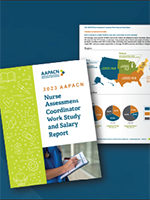Over the last few years, nurse assessment coordinators (NACs) are being hired with less long-term care experience, being paid more, and facing a multitude of challenges including stress and burnout, staffing shortages, and increased workloads. The 2023 AAPACN NAC Work Study and Salary Report received responses from 632 NACs. The respondents reported the greatest satisfaction with their salary when they had at least some but not substantial challenges with their workload, even though most of them reported a salary below the national average. A majority (55.9%) of NACs who reported being substantially challenged were also dissatisfied with their salary that was mostly below the national average (77.8%). The blue bar in the graphic clearly illustrates the correlation between a healthy workload challenge and salary satisfaction.

One way that leadership can help NACs feel less overwhelmed with their workload is to ensure that they have adequate time to complete the Minimum Data Set (MDS) assessments, attend all required meetings, and complete other duties as assigned. The NAC Work Study and the AAPACN full-time equivalent (FTE) calculator can assist NACs and their supervisors to calculate accurately the minimum time needed to complete their job assignments.
Here are five tips to reassess how many hours are needed in the NAC position to achieve adequate time for assessment completion and to reduce the perception of an overly challenging workload:
- Identify how many hours are needed to complete the comprehensive assessment for each resident: the MDS, Care Area Assessments (CAAs), and developing or revising the care plan. This calculation is best completed by the NAC, or in collaboration with the NAC, to determine the average amount of time it takes to complete this assessment. It’s important to identify the time required for the NAC(s) currently in the position because it will vary depending on experience in the NAC position, expertise in long-term care, organization of the medical record, completeness of the supporting documentation, and the clinical complexity of the residents.
The average completion time of surveyed NACs in the 2023 AAPACN NAC Work Study:
Total average completion time for comprehensive assessments: 2 hours and 48 minutes If the NAC also attended care conferences, this commitment averaged 38 minutes per resident. |
2. Identify the number of hours needed to complete each of the noncomprehensive assessment types (e.g., tracking records, Omnibus Budget Reconciliation Act [OBRA] assessments, Prospective Payment System [PPS] assessments). This part of the process is also best completed by the NAC, or in collaboration with the NAC, to determine the average amount of time required to complete these assessments. If the state also requires completing the Optional State Assessment (OSA), it should be included in the calculation.
Another essential consideration is the substantial increase in items added to the MDS as of October 1, 2023. Many of these are specific to the PPS 5-Day and PPS Part A Discharge assessments, but a considerable number of changes to the OBRA assessments must also be included. Establishing workflow processes and documentation expectations for direct care staff before October 1, 2023, will save time later on, rather than attempting to complete this assessment during the implementation of the new processes.
The average completion time of surveyed NACs in the 2023 AAPACN NAC Work Study:
|
3. Identify the hours per month required for meetings and other additional duties. MDS completion and submission is just one part of a NAC’s job. NACs are required to monitor if skilled care criteria are being met, update case managers, report changes in Quality Measures (QMs) and Five-Star ratings, and educate team members as needed. In the 2023 AAPACN NAC Work Study, surveyed NACs reported on their attendance and frequency of nine meetings they often attended. Although the NAC often offers valuable input and/or finds these meetings worthwhile, all the time spent at meetings should be accounted for when determining how many hours are required for the NAC position.
The 2023 AAPACN NAC Work Study also reported that about a fourth of NACs surveyed also work remote hours: on average, only 13 hours per week. Any remote work must be included in the FTE calculation. Leaders shouldn’t forget the other duties that may also be assigned to the NAC. Time spent in QM oversight, International Classification of Diseases, Tenth Revision, Clinical Modification (ICD-10-CM) diagnosis coding, and technology support can add up quickly.
4. Run a report to determine how many assessments per type were completed within the time frame assessed. AAPACN recommends reviewing at least a three-month period to analyze the number of assessments completed due to fluctuations in the census that may occur during a shorter time period. Once the time period is selected, run a report to identify how many assessments, per type, were completed. Although reports are often available in the facility’s MDS software, the MDS 3.0 Activity report in the Internet Quality Improvement and Evaluation System (iQIES) will show all accepted assessments and tracking records during a selected time period. Note: Any assessments not submitted to iQIES, such as for Medicare Advantage plans, need to be calculated separately.
5. Enter information into an FTE Calculator. AAPACN created the Nurse Assessment Coordinator FTE Calculator FY 2024 tool, available free for members, to calculate NAC FTE needs. This Excel tool provides instructions on one tab and the calculator on the next tab. Once all fields are completed, the tool calculates the recommended FTE need. One FTE is equal to one 40-hour per week NAC. If the calculator shows the need is 1.5 FTE, it equates to one full-time NAC and one part-time NAC working 20 hours per week.
This AAPACN resource is copyright protected. AAPACN individual members may download or print one copy for use within their facility only. AAPACN facility organizational members have unlimited use only within facilities included in their organizational membership. Violation of AAPACN copyright may result in membership termination and loss of all AAPACN certification credentials. Learn more.

